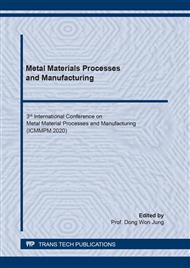p.3
p.13
p.23
p.33
p.43
p.51
p.59
p.65
Numerical Analysis of Aerospace Nickel-Based Single-Crystal Superalloy Weldability Part II: Nonequilibrium Solidification Behavior
Abstract:
The thermal metallurgical modeling by coupling of heat transfer model, dendrite selection model, columnar/equiaxed transition (CET) model and nonequilibrium solidification model was further developed to numerically analyze stray grain formation and solidification temperature range on the basis of three criteria of constitutional undercooling, marginal stability of planar front and minimum growth velocity during multicomponent nickel-based single-crystal superalloy weld pool solidification. It is indicated that the primary γ gamma phase microstructure development and solidification cracking susceptibility along the solid/liquid interface are symmetrically distributed throughout the weld pool in (001) and [100] welding configuration. The microstructure development and solidification cracking susceptibility along the solid/liquid interface are asymmetrically distributed in (001) and [110] welding configuration. Appropriate low heat input (low laser power and high welding speed) simultaneously minimizes stray grain formation, grain boundary misorientation and solidification temperature range in the vulnerable [100] dendrite growth region and beneficially maintains single-crystal nature of the material in the [001] epitaxial dendrite growth region to improve the cracking resistance, while high heat input (high laser power and low welding speed) increases the solidification cracking susceptibility to deteriorate weldability and weld integrity. The solidification temperature range in (001) and [110] welding configuration is detrimentally wider than that of (001) and [100] welding configuration due to crystallographic orientation of dendrite growth regardless of heat input. The mechanism of asymmetrical crystallography-dependant solidification cracking because of nonequilibrium solidification behavior is proposed. The elliptical and shallow weld pool shape is less susceptible to solidification cracking for successful crack-free laser welding. Moreover, the promising theoretical predictions agree well with the experiment results. The useful modeling is also applicable to other single-crystal superalloys with similar metallurgical properties during laser welding or laser cladding.
Info:
Periodical:
Pages:
33-41
Citation:
Online since:
January 2021
Authors:
Price:
Сopyright:
© 2021 Trans Tech Publications Ltd. All Rights Reserved
Share:
Citation:


